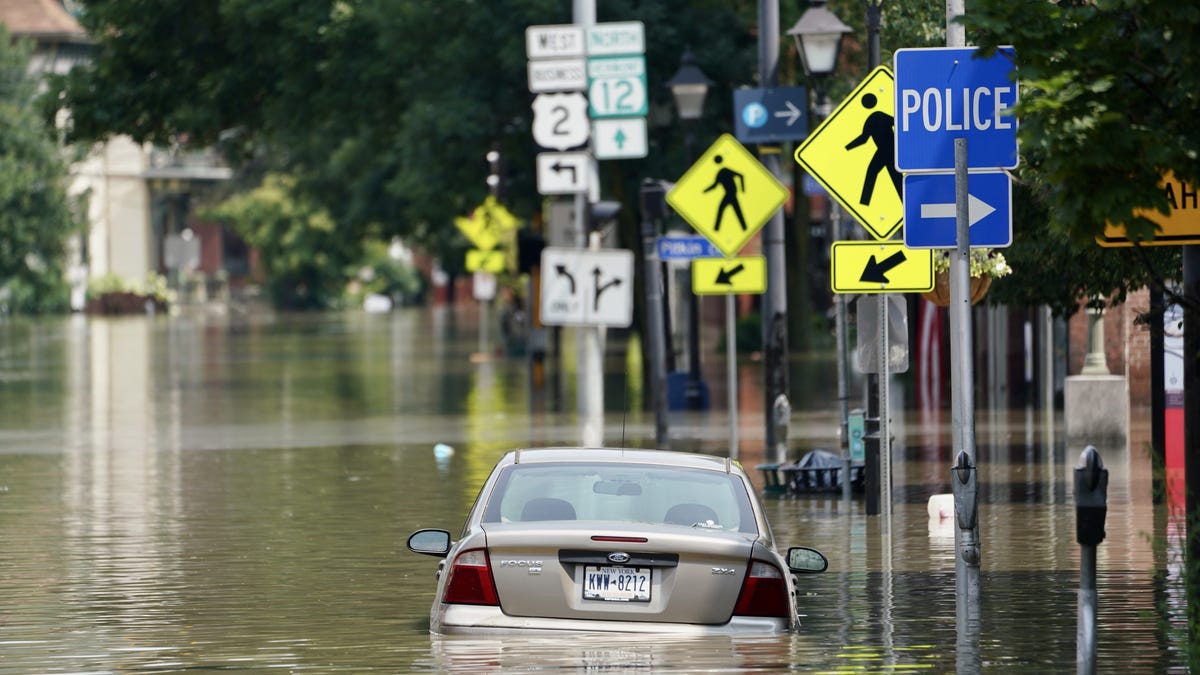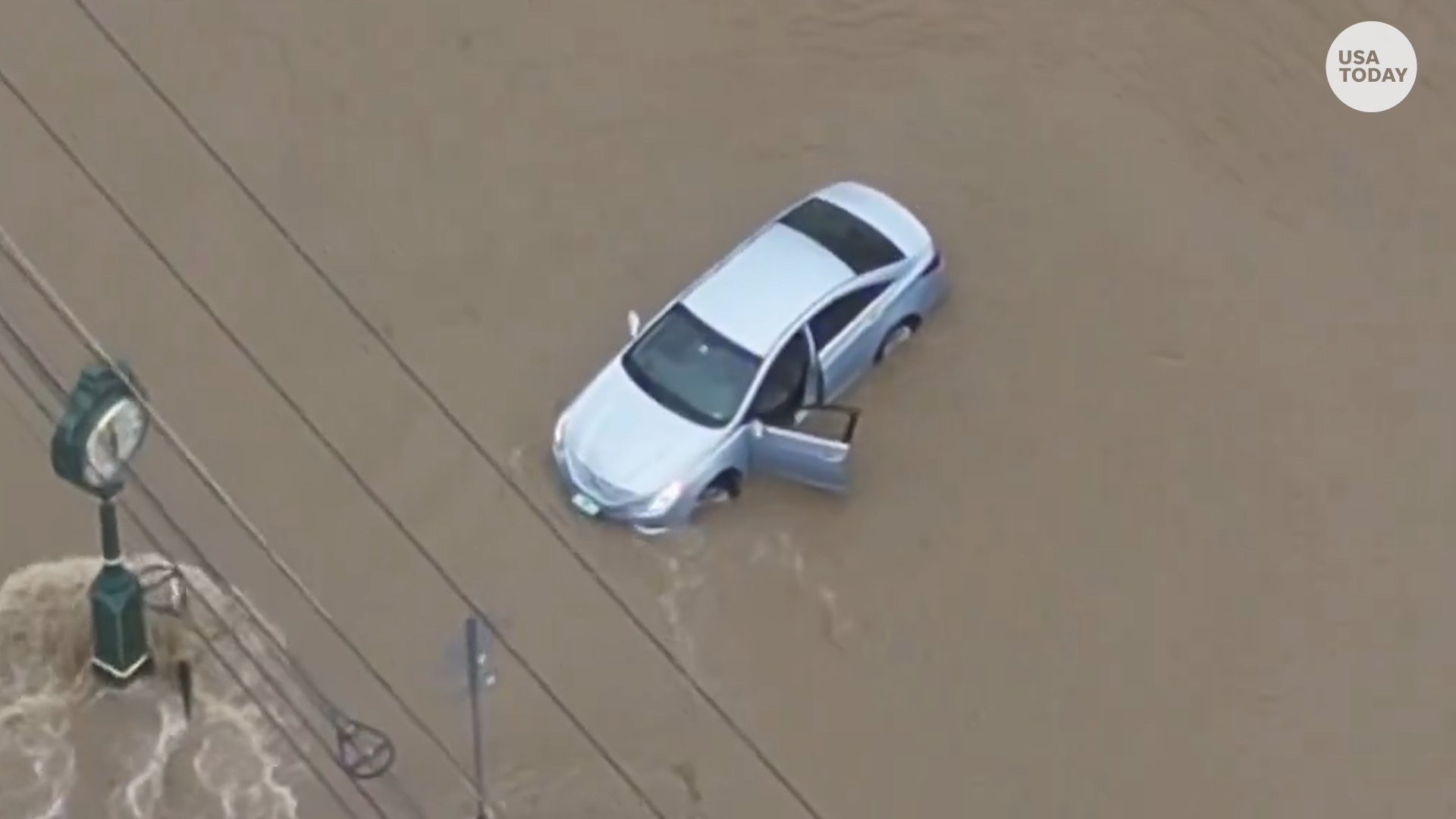
MONTPELIER, Vt. − Stunned and soaked, residents paddled through the main streets of the capital city of Vermont Tuesday after torrents of rain lashed the Northeast, causing deadly and catastrophic flooding that has already resulted in tens of millions of dollars of damage throughout the state.

The onslaught – up to 9 inches of rain in parts of Vermont – knocked out radio towers used to dispatch emergency vehicles. Police, fire, and public works crews moved to a water treatment plant in a nearby town because of heavy flooding at the police department’s basement, at city hall, and at the fire department.
President Joe Biden declared an emergency in the state. Vermont Gov. Phil Scott warned residents that waters were still rising early Tuesday.
“We are not out of the woods,” he said at a news conference. “This is nowhere near over.”
Residents grabbed pets and scrambled to higher ground. Authorities said they had carried out more than 175 rescues by Tuesday night, including dozens from flooded buildings, homes, and cars.
There were no reports of injuries or deaths.
National Guard helicopters were also conducting evacuations in remote areas that water rescue teams weren’t able to access and many were still deployed Tuesday night.
For those who made it to safety, once the waters began to recede, what was left was worry, and concern over what the waters had taken, and what would be left behind.
“It was just ‘whoa.’ It becomes real when you see it,” said Alaina Beauregard, 19, who paddled a green canoe across downtown Montpelier on Tuesday just before noon, looking for gas.

Vermont hit with severe flooding, evacuations following heavy rainfall
Forced evacuations were ordered for residents in parts of Vermont as severe flooding damaged homes and washed out roads.
Damien Henderson, Storyful
In places, the smell of paint thinner and garbage hung heavy in the air.
Floodwaters typically contain a toxic stew of chemicals pulled from inundated buildings, from gasoline and paint to sewage and household cleaners and these Vermont floodwaters were no different.
The flooding struck at the height of Vermont’s summer tourist, season, and many locals worried it would pile yet another challenge upon already struggling local businesses.
Beauregard and Gavin Young, 18, have been housesitting and realized that without gas, they wouldn’t be able to get anywhere once the waters recede.
“We are witnessing a powerful act of nature,” Young said. “Being able to canoe on the streets we grew up on? It’s sort of an amazing feeling but then you see all the stores underwater and all the damaged goods.”
Across the small city, fire alarms screeched as shop owners tried to access their properties and mourned the destruction.
Kelly Tackett, who owns the Minikin children’s store on State Street said she allowed her catastrophic Insurance policy to lapse last month because business has been so slow.“What can I do? It’s wild. It’s eerie. But somehow I’m not overly worried, because what can I do?” Tackett said. “I didn’t take the warnings seriously at first. It didn’t even cross my mind to do that but thankfully I dragged my kids down and we raised everything up two feet.”
She said business has been slow for months and this could be the final days for her shop. She couldn’t pass the floodwaters to see her business but asked a journalist to take some and send them back to her.“Seeing the photos is just awful, really,” she said later. “I’m still in tears looking at them. This was my lifelong dream shop, I finally decided to go for it and opened during Covid. Those photos make me realize this is likely the end of Minikin. I worked so hard to bring it to life. “
By 1:30 PM, a steady stream of water was rushing past the state’s iconic capitol building. As waters began to recede Tuesday, officials were able to begin assessing the damage and potential clean-up efforts.
While river levels at a dam just upstream appeared to be stable, officials said it was still a concern for the city.
Roads flooded across much of Northeast
Across the region, almost 4 million people faced flood warning, watches or alerts, including in parts of New York, New Hampshire, and Maine.
Six swift-water rescue teams were activated in New York state, where rain totals in some areas surpassed 8 inches and road closures swept across Orange, Westchester, Ulster, Putnam, Dutchess and Rockland Counties. New York Gov. Kathy Hochul declared a state of emergency for Orange and Ontario counties.
The lone death from the flooding was reported in New York’s Hudson Valley, where police said Pamela Nugent, 43, died as she tried to escape her flooded home with her dog in the hamlet of Fort Montgomery, 50 miles north of New York City.
But on Tuesday, Vermont suffered the brunt of the deluge. Several miles of Interstate 89 were closed for hours in both directions between the capital of Montpelier and Middlesex.
In Montpelier, people were urged to call dispatchers only in “an extreme emergency” because first responders were “spread very thin” and at “max capacity.”
Biden authorized the Federal Emergency Management Agency to coordinate disaster relief, seeking to blunt hardship and suffering. Scott, the governor, said the declaration covering all 14 counties allows state and federal authorities more flexibility to deploy desperately needed equipment and resources.
Crews from North Carolina, Michigan, and Connecticut were among those helping rescuers to get to Vermont towns left inaccessible by floodwaters.
With waters receding later Tuesday, Montpelier Town Manager Bill Fraser said the city was shifting to a recovery mode, and public works employees were expected to start clean-up operations Wednesday morning. Building inspections will begin once businesses are able to clean up their properties.
“The dam did not spill over. The water in the dam is still up there but it stabilized. We are feeling like the water going over the spillway of the dam is not an imminent threat,” Fraser said. “It looks like it won’t breach. That is good. That is one less thing we have to have on our front burner.”
‘Heartbreaking to see’: Vermonters lament widespread damage
By midday, the water had begun to recede and the dam held. What was left was the damage.
“It’s heartbreaking to see,” said Elen Surdel, 59, who rode out Hurricane Irene in 2011 and said this was worse. She and her husband live up a hill outside of Montpelier but came into town to help evacuate friends.
“This is worse. There’s a lot more water, a lot more people affected here in central Vermont. No one has been hurt, which is good, but this is the peak of the tourist season and this is going to take a couple of weeks to clean up. I’m afraid some of the businesses might not survive.”
Troy Caruso, who owns a golf course, five restaurants and a motel in Ludlow, Vermont, has been monitoring damage to his properties and elsewhere in the town of about 800 people. A supermarket and shopping center were “wiped out,” he said, as was a steakhouse and possibly a burger joint he owned.
“It’s flooded beyond belief,” Caruso said, noting that the 10th hole of his golf course was underwater.
Vermont state Rep. Kelly Pajala said she was among several people evacuated from a four-unit apartment building on the West River in Londonderry.
“The river was at our doorstep,” she said. We threw some dry clothes and our cats into the car and drove to higher ground.”
While the region is expected to be dry on Wednesday, more showers and thunderstorms are in the forecast for Thursday, the National Weather Service said.
A few additional inches of rainfall is likely across much of Vermont, eastern New York, and neighboring New Hampshire, which could exacerbate flooding, the weather service said Tuesday.
Travelers thinking twice about a trip in the wake of the flooding have some options.
Those who have a booking on vacation rental platform Airbnb can cancel via its website or mobile app. Travelers can find the cancellation policy and options for their reservation under “Trips.”
Airbnb also has an extenuating circumstances policy that covers natural disasters, government-declared local or national emergencies, and other unforeseen disruptions. “Guests that are impacted by an event covered by this Policy can cancel their reservation and receive, depending on the circumstances, a cash refund, travel credit, and/or other consideration,” the platform said on its website.
In cases where that policy applies, it supersedes the booking’s cancellation policy, though it does not cover “weather or natural conditions that are common enough to be foreseeable in that location,” among other exclusions. The policy also does not apply to Luxe bookings, which have a separate refund policy.
After travelers read the extenuating circumstances policy to see if their booking is covered, they can select “I have an extenuating circumstance” while canceling the stay or experience and contact Airbnb to file a claim. Guests must submit their claim within 14 days of canceling.
Those who have a reservation booked with Vrbo can cancel via “My Trips” after signing into their account. They can find the property’s cancellation policy under “Trip Details.” Refunds are issued based on the property’s cancellation policy.
“If a natural disaster, such as a hurricane, earthquake, or tornado, impacts your reservation, and you require immediate assistance finding alternative accommodation, please contact us,” Vrbo said on its website. Those who have not left for their trip yet should contact their host.
Contributing: Nathan Diller, USA TODAY; April Barton, Burlington Free Press; The Associated Press
{ link.setAttribute(‘href’, url); }); } })(); function fireNavShareAnalytics (type) { try { let analytics = document.getElementById(“pageAnalytics”), section = ga_data.route.sectionName || ga_data.route.ssts.split(‘/’)[0]; if (analytics) { analytics.fireEvent(`${ga_data.route.basePageType}:${section}:nav-share-buttons:${type}`); } else { if (window.newrelic) window.newrelic.noticeError(‘page analytics tag not found’); } } catch (e) { if (window.newrelic) window.newrelic.noticeError(e); } } ]]>
Source



